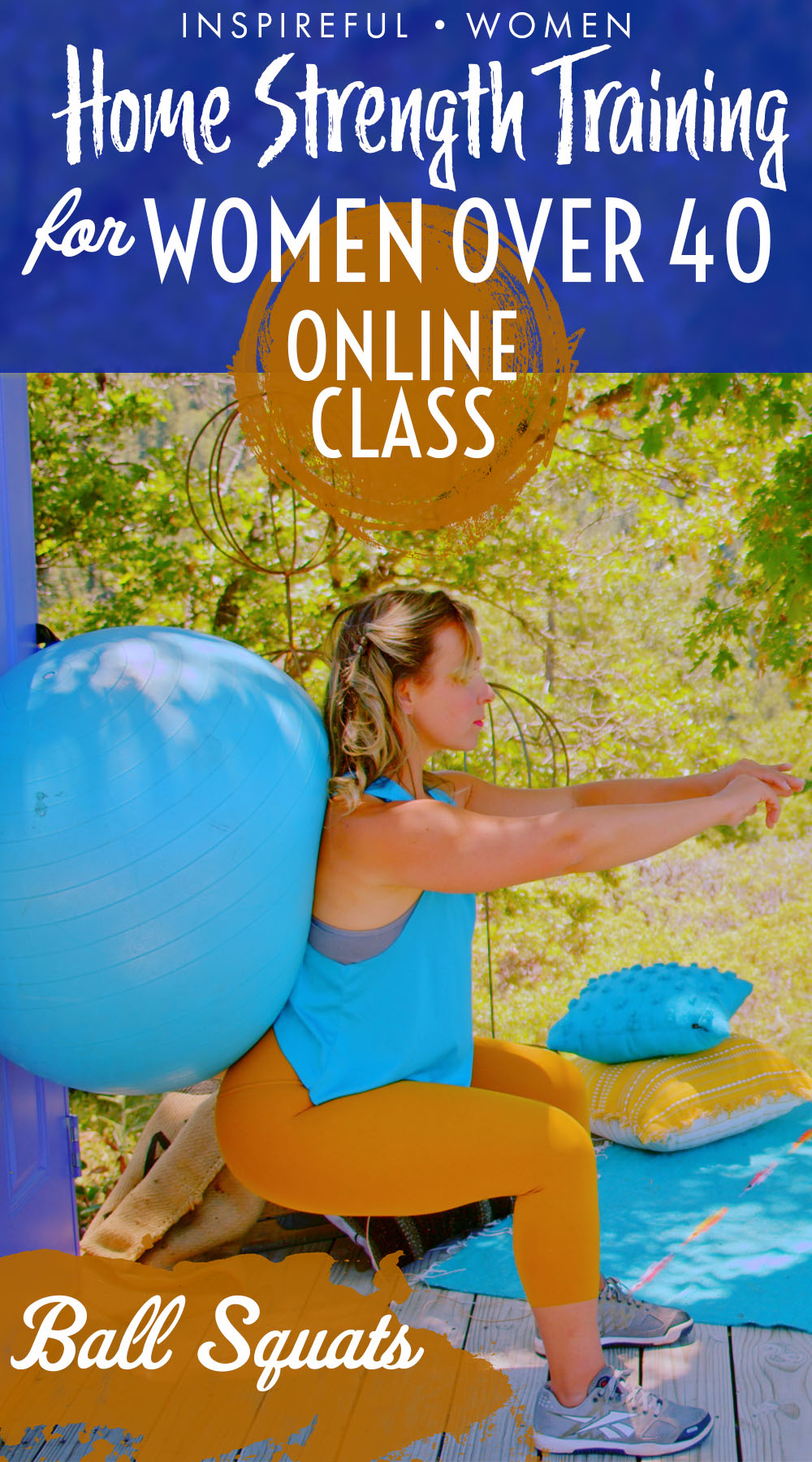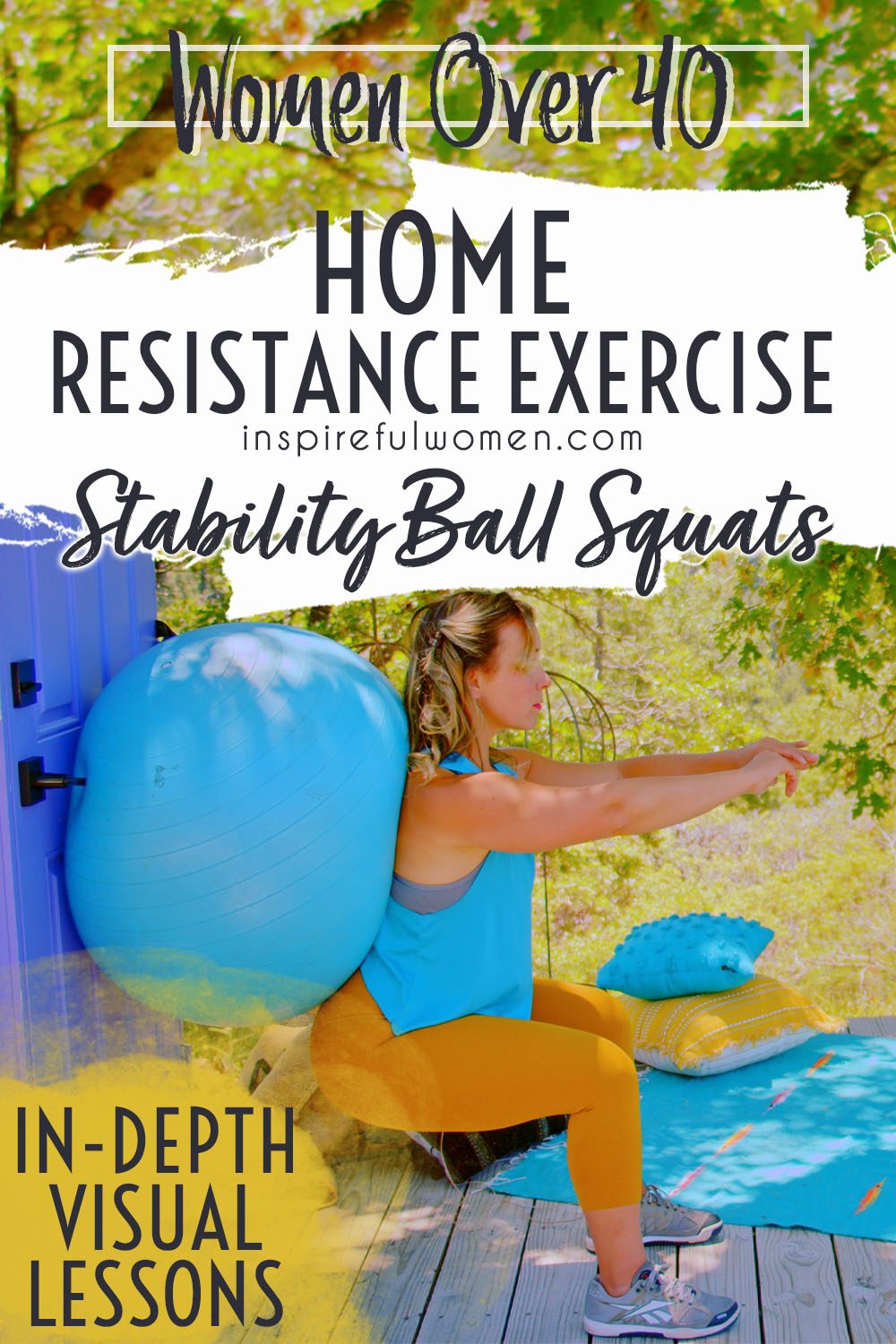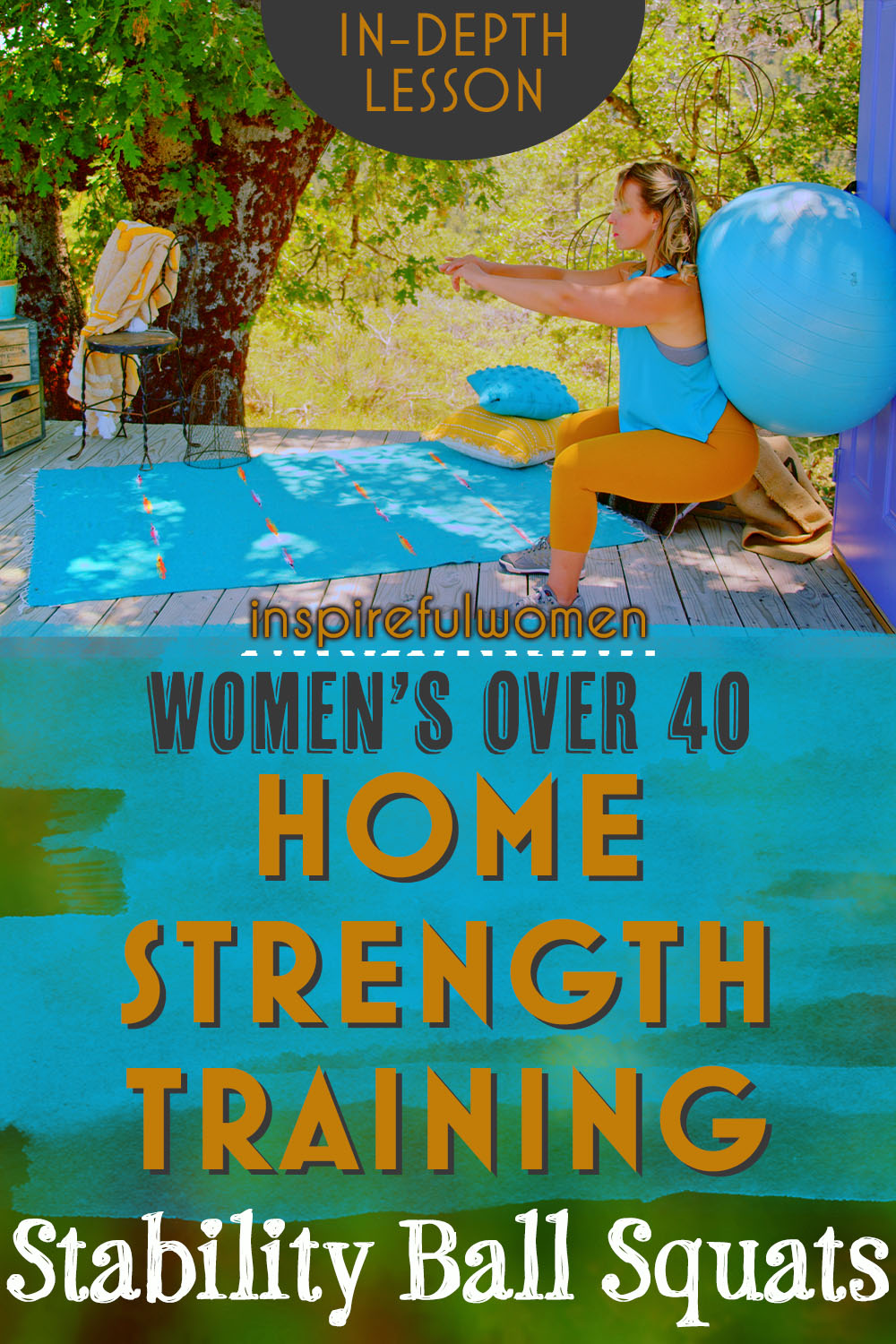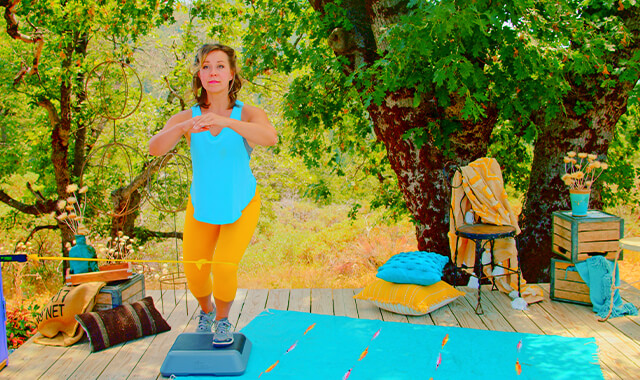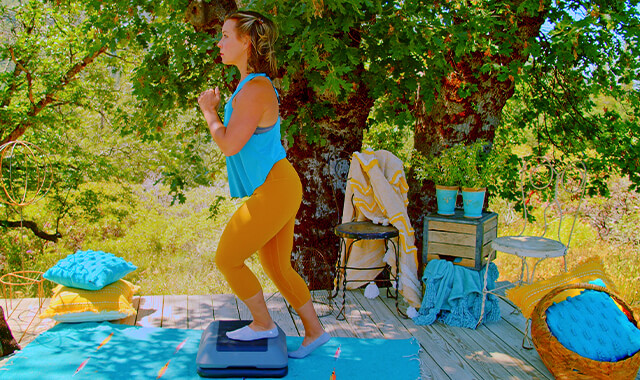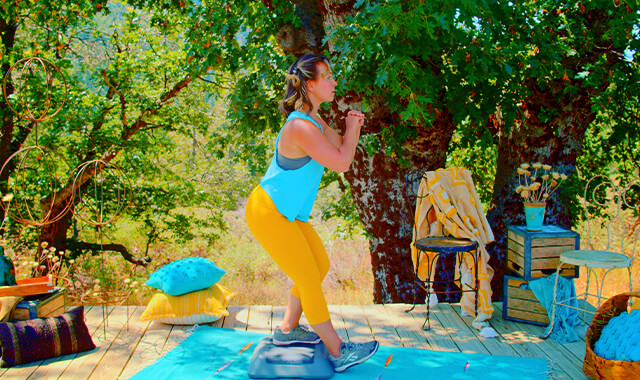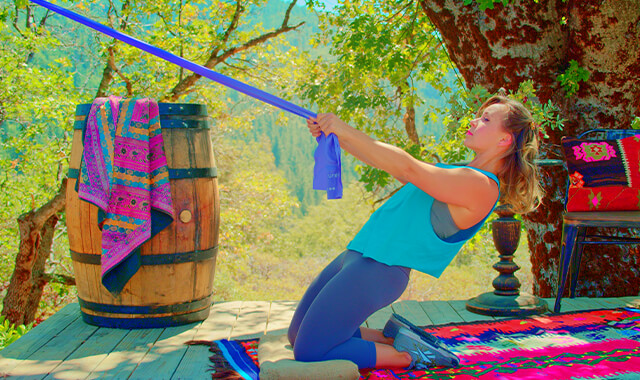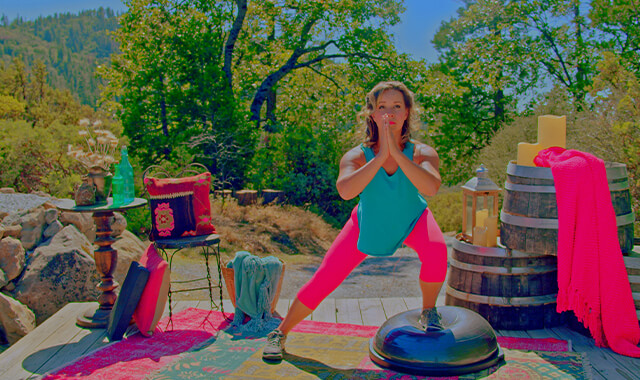Stability Ball Squat
How to Do the Swiss Ball Squat - Modified for Bad Back & Knees | In-Depth Guide [VISUAL LEARNERS] Beginner
Proper Form, Common Mistakes, & Variations | Home Resistance Training
WHAT DO YOU WANT TO SEE?
QUICK DEMO
QUICK DEMO
MUSCLES THIS WORKS
MUSCLES
MAIN MUSCLES WORKED IN the Stability Ball Squat
QUADRICEPS & GLUTEUS MAXIMUS
OTHER MUSCLES WORKED:
- Gastroc/Soleus
- Hamstrings
- Erector Spinae
STARTING POINTERS
Starting Pointers
WHAT WE'RE DOING TODAY
ALL WE'RE DOING:
With your back against a ball, you will hold the bottom of a squat.
The Swiss Ball Squat is an engaging and effective exercise that adds an element of instability to the traditional squat, making it an excellent choice for improving balance, core stability, and lower body strength.
Main reason for choosing Stability Ball Squat: Knee or back pain with regular squats, or limited thoracic, hip, knee, or ankle range of motion. Core or leg weakness.
This version of the squat uses a stability ball to help support your back and stabilize the spine. The ball is placed on a wall, with the curve of your lower back being supported by the curve of the ball. To squat down, you will be rolling down the ball, pushing your hips back under the ball. The ball will be further up your back at the bottom of your squat. This is a good option for working on the range of motion of the hips and thoracic spine, and to strengthen your leg muscles. The lower you are able to go down, the more range of motion you will get in the hips, knees, and ankles. The curve of the ball rolling up to the upper back helps to mobilize the vertebrae by applying gentle pressure to move them just slightly forward (extension).
The hips move back under the ball, this supports your upper back and allows you to keep the lower leg (shin) and upper back more vertical. This version of the squat is great if you have knee or back pain with regular squats, or limited knee or ankle range of motion. The knee will be directly above (in line) with the ankle, the knee does not move forward over the toes. This position puts less stress on the joint between the kneecap and the thigh bone - a common source of discomfort. The ball also supports the low back. This version is less challenging for the core muscles because the torso is supported by the ball.
Per Carol: In this version, the knee stays over the ankle - that is one of the great benefits. It is really good for people who have knee pain or a limited range of motion in their knees or ankles.
It is great if you have knee pain because you are limiting the force in the patello femoral joint by keeping the knee back over the heels. It is not better for working on hip range of motion than the other squats - it allows someone who has knee/back issues or limited ankle range of motion to use a squat to work on leg strength and hip range of motion. You may need to play around with the position of the ball on the back, it looked much better when you moved it up.
HOW TO DO THE EXERCISE
LOOKS
HOW Stability Ball SquatS SHAPE OUR BODY
Firm and shapely thighs and buttocks.
PROPER FORM
PROPER FORM: Stability Ball Squats
EQUIPMENT, SETS & REPS
EQUIPMENT
STABILITY BALL
Tip: It's best to get one that has a slightly textured feel to it, like the pearlescent ones. If they don't have a textured surface, the ball tends to be slippery on the surface (carpet, floor, whatever) and it can come out from under you pretty easily (ask me how I know).
Here are my recommendations that have a textured surface:
One size, many color options. I have one of these at home and it doesn't slip.
Galsports has different size options for the ball which is nice if you are fairly tall or fairly short. Your height will change what size ball will be the best for you. I have one of these in the Large size, which is about the "standard" ball size, and it works well. The small size is too small for our purposes no matter your height.
Wall, Barefoot, or shoes (to prevent slipping).
SUGGESTED STARTING WEIGHT FOR WOMEN:
Bodyweight
SETS & REPS:
2 sets of 8 reps
PACE:
Slow and controlled.
BODY POSITION
BODY POSITION FOR THE Stability Ball Squat
Place a stability ball against the wall, and place your back on the ball. Position the ball so that the curve of the ball is at the curve of your low back. You will be leaning back into the ball with your legs angled out in front of you - the exact distance from the wall is dependent on the size of the ball and your body. You may need to move your feet after you try the movement.
FEET: Hip width apart, toes pointed forward.
BODY STANCE: Neutral spine (includes neck) - low back supported by the ball. Core muscles gently engaged. Sternum lifted, shoulders back on the ball.
ARMS: Arms by your sides or out in front parallel to the floor.
HOW TO DO
HOW TO DO Stability Ball SquatS
CUE: You will be leaning back, and your knees should stay over your ankles. You may need to adjust your foot position after the first squat.
Actively bend at your hips, pushing your hips under the ball. The ball will be behind your upper back/head (depending on how low you squat).
Lower down until your thighs are parallel with the floor or lower - as long as your low back stays neutral.
Your knee will be directly above (in line) with your ankle, your knee does not move forward over your toes.
Pause in the end position, then push into both feet to straighten your knees and hips to return to standing.

COMMON MISTAKES
COMMON MISTAKES
WHAT TO AVOID WITH THE Stability Ball Squat
KEY TIP:
Guess what? Good news! Many avoids are the same for most movements. Once you learn the basics, there's really only a few extra avoids for each individual movement.
1. Avoid Tucking Glutes/Flexing Lumbar Spine
AVOID: Rounding your back/”tucking your tail”.
WHY NOT?
- This is the most common mistake made, in an attempt to go deeper into the squat, the tailbone is tucked under.
- This can lead to increased pressure on the spine, and lead to injury or damage over time.
- Tucking the tail, and rounding the low back defeats the purpose of going deeper into the squat.
WHAT TO DO:
- The goal for going deeper is to strengthen the core and increase the range of motion of the hips and ankles.
- Tucking the pelvis under does not increase the hip or ankle range of motion.
- Keep your spine from head to tailbone neutral throughout the movement.
- Keep your shoulders back and sternum lifted.
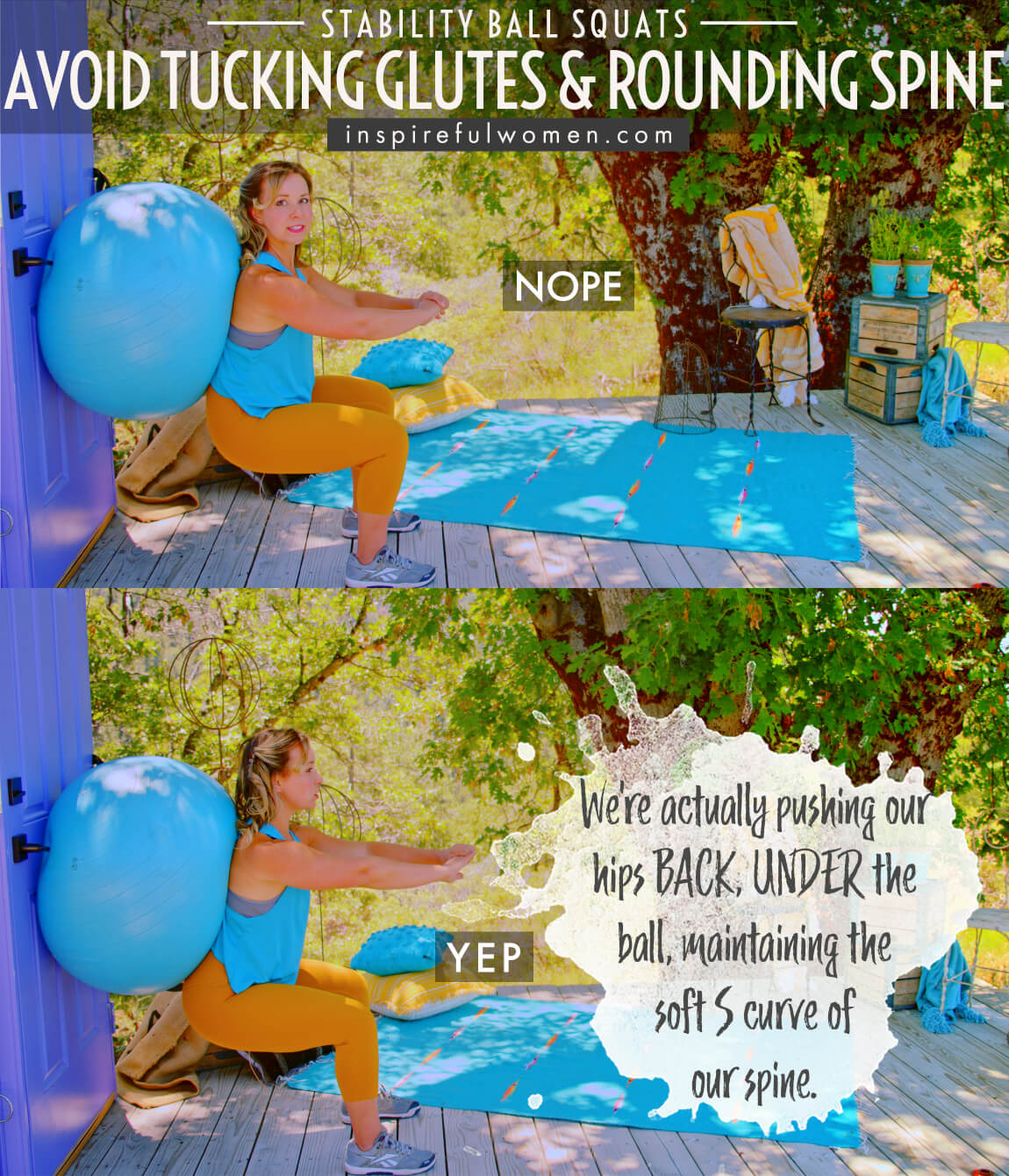
2. Avoid Feet Too Far In
AVOID: Having your feet too close or far from the wall.
WHY NOT?
- If you are too upright in the start position, this will cause your knees to move forward over your toes as you squat.
WHAT TO DO:
- By having the feet a bit further from the wall in the start position when you squat, your knees will remain over your ankles, which is the desired goal in this squat version.
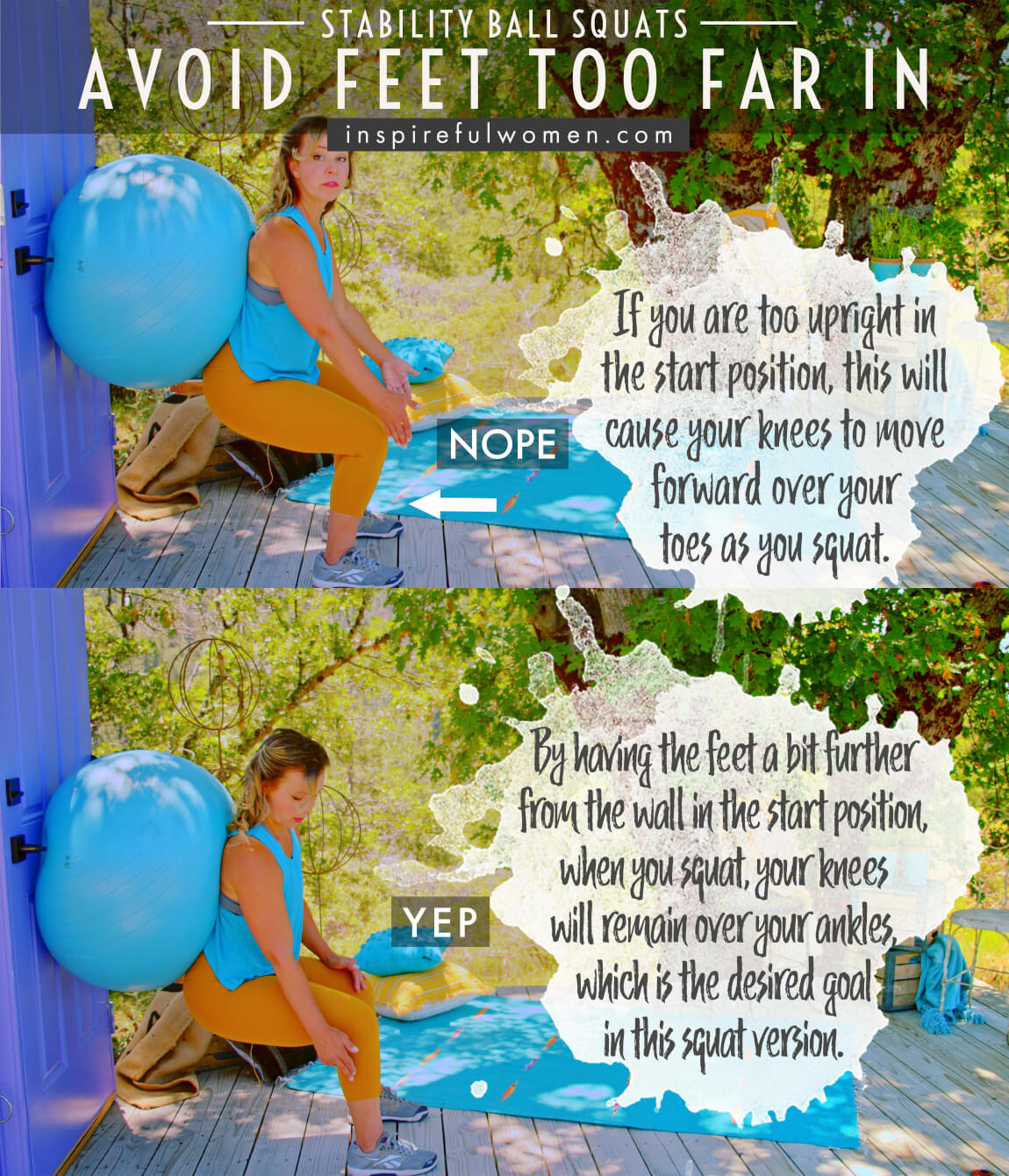
3. Avoid Knees Moving Forward
AVOID: Knees coming forward.
WHAT TO DO:
- Push the hips back as you squat down, rather than moving forward at the knees. Knees should stay vertically over the ankle, not the front of the foot.

4. Avoid Hands On Thighs
AVOID: Resting hands on thighs.
WHY NOT?
- It is fairly common for people to do this to help the leg muscles by pushing the weight back into the wall and increasing friction between the wall and the back.
- This can decrease the muscle activity of the quadriceps.
WHAT TO DO:
- Keep the hands by your sides or straight out to the front - parallel to the floor.
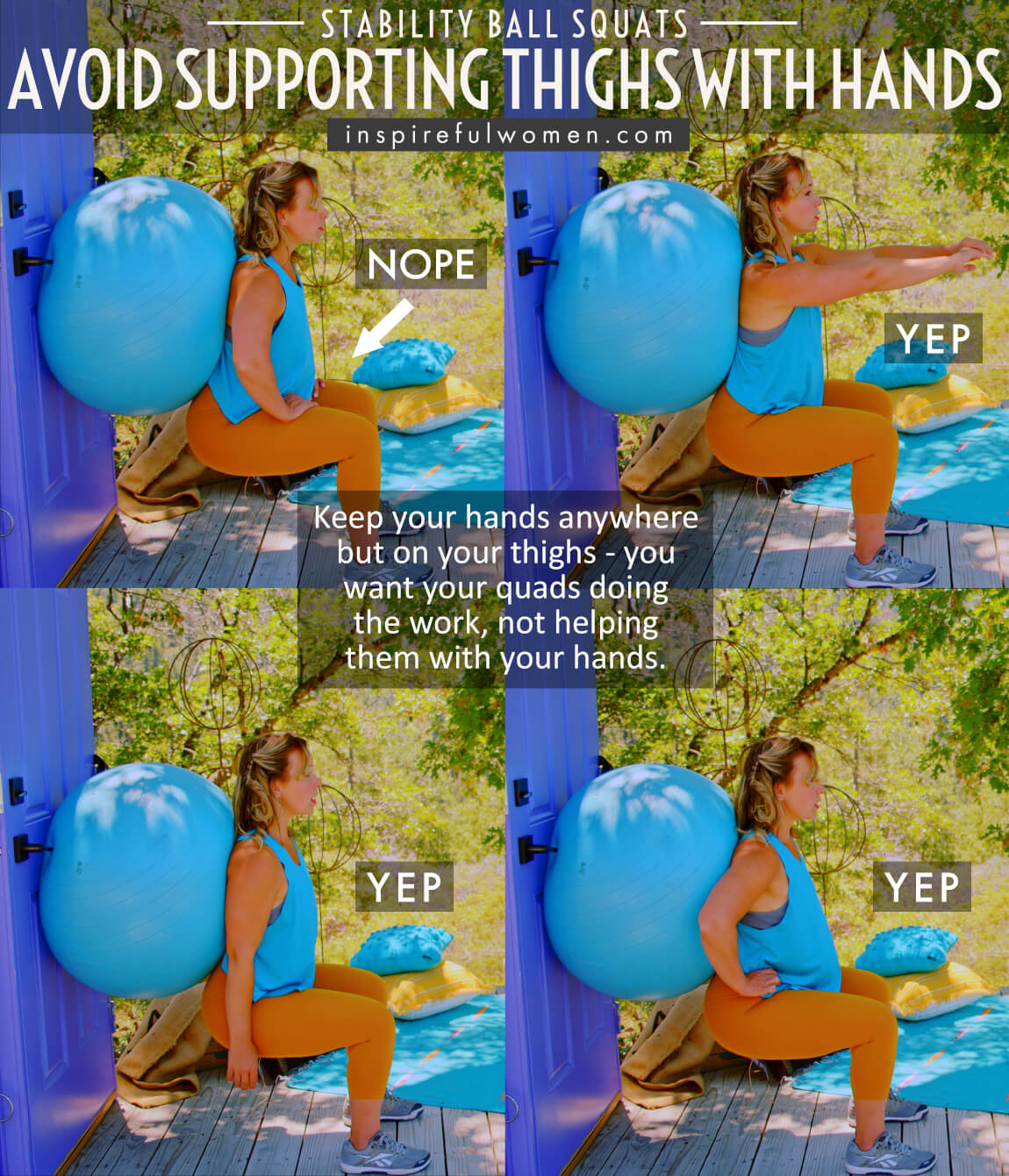
5. Avoid Knees Caving In/Out
AVOID: Letting your knees collapse in - during any part of the movement.
WHAT TO DO:
- The knee joint should be in line with the toes, shin, and thigh.
- Pay attention to this alignment on the way down and on the way up.
- This requires activation of the gluteus medius muscles to hold the thighs out.
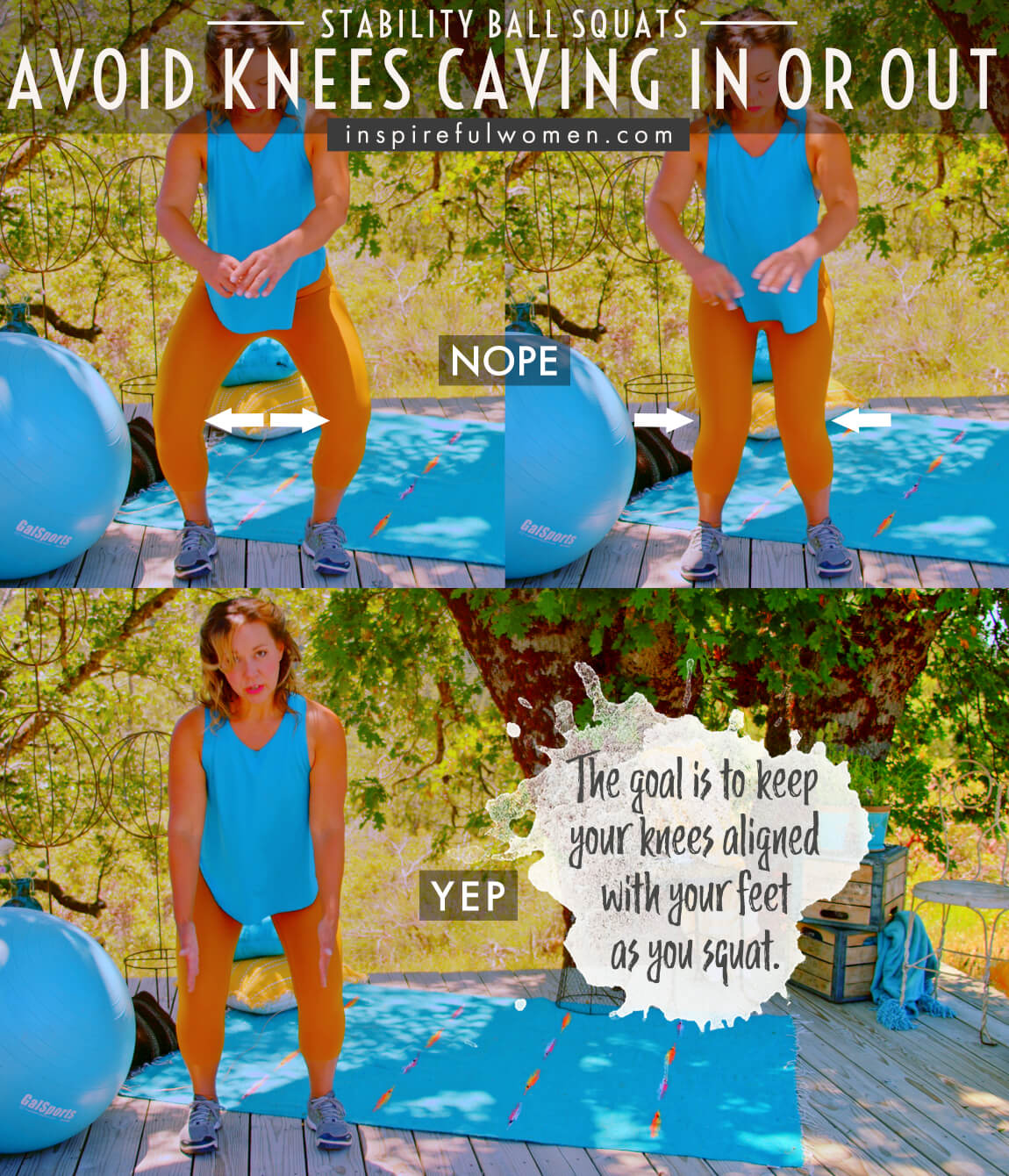
VARIATIONS
VARIATIONS
VARIATIONS OF Stability Ball Squats
Iso Hold
Isometric Hold
To work on muscular endurance: Lower down as far as you are able while maintaining good form and hold the position. 3 reps to fatigue - when form fails - no longer able to hold the position; or 3 sets of 45 seconds.

WHAT WE'RE DOING TODAY
WHAT & WHY
BENEFITS OF TRAINING THE Quadriceps
WHAT
This is a bodyweight isometric quadricep exercise. Squats can be modified to change the focus of the movement and can help us to improve in an area of our squat that we might be having trouble with.
The modifications all require the use of some sort of equipment, either a ball, wall, box (bench or chair), dumbbell, or band. Choosing which modified squats to do should be based on your ability and your goals. Squats can be slightly modified to accommodate personal limitations in core strength, hip, knee, ankle, or upper back stiffness or muscle tightness, and leg strength. The modifications do not necessarily make the exercise easier, just different. All of the modified versions of the squat focus on strengthening the quadriceps and gluteus maximus muscles, and involve movement at the ankle, knee, and hips.
- If you want to improve the muscular endurance and strength of the quadricep muscles:
- Try Wall Squats
- If you have difficulty:
- Keeping the heels on the floor during the basic squat
- Try: Wall Squat, Ball Squat, or Box Squat.
- Keeping the upper body upright (parallel with the shins/leaning the head and shoulders too far forward)
- Try: Wall Squat, Ball Squat, or Banded squat.
- Keeping your spine in neutral or back pain by squatting
- Try: Ball Squat
- Keeping the heels on the floor during the basic squat
- If you want to work on getting the thighs past parallel to the floor
- Try: Ball Squat or Banded Squat
Keeping the small curve in the low back as you squat down can be hard for a lot of people. It may be helpful to actively pull yourself down at the beginning of the squat. One of the hip flexors (iliopsoas) is attached to the low back (the lumbar part of the spine). Activating these muscles can make it easier to hold the low back in a neutral position.
WHY BOTHER DOING IT?
WHY
WHY DO WE EVEN CARE?
Squats are very functional and fairly simple to do. Our bodies were designed to squat - our ancestors squatted for many of their daily activities - like eating, washing clothes, going to the bathroom, and even talking. If you have the opportunity to watch children play, it is amazing to move in and out of a perfect squat position without effort, and hold the position while they play. However, if you’ve seen this, you’ve also properly thought, “wow I could never get into the position that kids hang out in.” Or we might be thinking just how much discomfort we’d be in if we tried to do that.
ACQUIRE/IMPROVE GOOD FORM WITH MODIFIED SQUATS
If you are not in the habit of squatting it can be challenging to do a squat. Personal limitations can interfere with your ability to squat in the correct form. It may be very useful to start with a modified version to build up the strength and joint mobility to be able to squat.
All of the modified squats do a great job of strengthening the leg muscles. In fact, the wall sit is the best squat to use to recruit more motor units - in other words - to activate the individual muscle fibers - get more muscles involved in the exercise. When you hold your body weight in the wall sit position the muscle fibers fatigue. In order to stay in the position, more fibers are recruited to help out. This is a nice way to improve your mind-body connection and the ability to activate more of the muscle. The wall sit works really well for this because you are holding the position where the muscle is being challenged the most (thighs parallel to the floor).
PUT MOVEMENT BACK WHERE IT BELONGS, AND GET RID OF MOVEMENT WHERE IT DOESN’T BELONG.
With age we tend to lose mobility in the ankles and hips - they get stiffer. When those joints get stiffer, it changes the way that we move. We begin to use our low backs more and our legs less. Over time this leads to backs that move too much and weaker legs. Slowly there can be a trend towards taking smaller steps when walking, not wanting to get down on the floor, using the hands to get up from the floor, and using gravity and the arms to help get out of chairs and upstairs. Adding squats to your workout can help prevent this from happening.
EVERYDAY LIFE
EVERYDAY LIFE &
MUSCLE FUNCTION
HOW WE USE OUR quadriceps & glutes IN EVERYDAY LIFE
The quadriceps and gluteus maximus muscles work together in activities that involve straightening the knee and the hip at the same time.
1. JUMPING
2. CLIMBING
3. GOING UP AND DOWN STAIRS
4. TRANSITIONING SIT TO STANDING TO SIT
- Sitting in chairs
- In and out of cars
- On and off of the toilet
5. SQUATTING DOWN/GETTING UP
- Getting things out of the bottom shelf
- Getting up and down from the floor
- Gardening
- Picking items or kids up
6. SHOCK ABSORBERS TO PROTECT THE ANKLE, KNEE, AND HIP JOINTS DURING:
- Walking
- Running
- Jumping
7. STABILIZES THE KNEE JOINT DURING ALL ACTIVITY THAT INVOLVES BENDING AND STRAIGHTENING THE KNEE.
- Positions the kneecap in the groove of the femur during knee movement
HOW TO FEEL WHAT MUSCLE IS WORKING
How to Feel What Muscle is Working
Quadriceps: Sitting upright, place your hand on the front of your thigh (of the test leg). Hook the ankle of the other leg to hold the test leg (the leg that your hand is resting on) in place. Try to straighten the test leg by lifting the foot. You will feel your quadriceps contract.
Gluteus Maximus: Place your hands on your bottom - about where they would be if you put your hands in your back pockets - with the palms on your buttocks. Push down into both feet as if you were pressing yourself up to standing. Try to keep the front of your thighs relaxed so that the muscles under your hands contract. Try activating only one side at a time.
SCIENCY STUFF
ALLLL MUSCLES & WHEN
ALL MUSCLES WORKING & WHEN DURING THE Swiss Ball Squat
The iliopsoas and rectus femoris (hip flexors) act concentrically to flex the hip to pull your body down. The quadriceps, gluteus maximus work eccentrically to help lower the body down into the squat position. The quadriceps femoris, and gluteus maximus contract concentrically to push the body back up to the starting position.
PIN IT FOR LATER!
